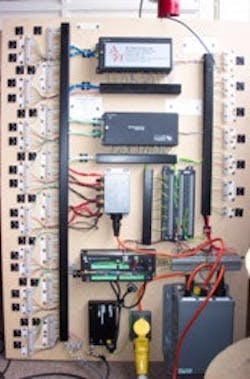Monitoring the Foyle Bridge
Structural monitoring specialists AV Technology have successfully completed a complex monitoring program for Farrans Construction during strengthening and refurbishment work on the spectacular and elegant Foyle Bridge in Northern Ireland.
AVT's crucial part of the project has involved the strategic installation of around 450 pre-wired full bridge strain gauges, 450 temperature sensors, 10 displacement sensors and eight jacking pressure sensors to keep a close eye on the behavior of the structure as the work was carried out. Over 6 km of wiring has been used throughout the bridge, connecting the sensors back to central data logging locations within the girders.
The 20-year-old bridge, which has a total length of 866 m, crosses the River Foyle near Londonderry and carries two separate carriageways of the A515. The three river spans comprise twin welded steel box girders of varying depth, with an orthotropic steel deck. The main span is 234 m, which is flanked by side spans of 144 m.
The overall project has been managed and supervised by Hyder Engineering, which has developed a ground-breaking and highly innovative technique for strengthening box girder bridges.
The Hyder solution has involved placing a series of huge compression struts along the bottom flange of the bridge. By adding controlled amounts of load into these struts, a tensile stress can be created in the box girder's bottom flange, reducing the “locked-in” compressive stresses resulting from the dead load. This removes the requirement to add local strengthening to the bottom flange with all its associated welding and fitting problems.
Keeping a close eye on the bridge behavior during the installation and stressing of the struts was of vital importance. The AVT data logging system had the capacity for over 300 channels and was based on multiple Campbell Scientific CR10X data loggers with 10 32-channel multiplexers and a multi-drop network. This enabled several loggers to be “daisychained” to the central PC running the real-time display software. In addition, the system incorporated a GSM modem to enable remote monitoring of data by AVT from their offices in Stockport.
AVT employed the services of controlled hydraulic jacking specialists Bill Boley Ltd. to fit and execute an innovative jacking system involving 48 individual high-capacity jacks, arranged into eight sets, one per strut section. These were used to prestress the tubes to relieve the large compressive stresses in the bottom flanges of the girder. Controlled loads in the region of 1,000 tons were applied to the tubes, and this jacking actually lifted the center of the bridge spans by around 100 mm. Pressure readings from the jacks were fed into the overall monitoring system, and when the required prestress level was reached the precision machined-tapered steel locking-off wedges was finally welded in place.
